Jodi Simmons
Finding a commercial venue devoted exclusively to contemporary sacred art is something just short of the miraculous, so, I felt an odd sense of awe, as I wondered through the JHS Gallery in Taos, New Mexico, for the first time. There were studies of a multi-cultural Jesus by Feminist Artist Janet McKenzie in the entrance room, while the second showcased reverse glass icons by Liesel Paris, an Austrian artist living in California. The last room had abstract copper pieces, colored in acid, suggestive of spiritual transformations, by Metal Sculptor Daryl Coburn, alongside a crucifix-like piece constructed out of an old gas pump by Mixed Media Artist Robert Ensor.
What really caught my eye was an icon hanging in the office of Gallery Owner Jodi Simmons. It showed Christ on the Cross with the golden rays of the rising sun visible in the background. When I asked about the striking Crucifixion-Resurrection scene, Simmons told me she had made it. I was impressed. She was not just brave enough to open a gallery, promoting other contemporary sacred artists--she was also pushing the limits of iconography in her own work.
Jodi told me she had never given much thought to religious art, until a near death experience turned her life around, and she felt the desire to express her new found faith in visual terms. Simmons took art courses and was making beautiful copies of religious paintings by the Great Masters, when a friend suggested she see the iconostasis in a Ukrainian Catholic Church in Deerfield, Massachusetts. The experience was so moving, Jodi knew this was the kind of art she was meant to make. Said Simmons: “I began studying, painting, and praying with what has become the greatest mystery, joy, teacher and friend in my life: the icon.”
When I asked Jodi that day, if I could see more examples of her work, she told me her responsibilities at the art gallery left little time for making icons in egg tempera in the time-honored way. A year or so later, I heard the news Simmons was selling up in Taos and moving to New England with mixing feelings. The closing of JHS Gallery was a real loss, but I knew Jodi would return to making icons, helping to revitalize a sacred art form not known for innovation or experimentation.
In the eyes of traditional Eastern Orthodox icon-writers, Jodi crosses over canonical boundaries in her handling of sacred subjects. Why, for example, is Christ shown so often without a beard? And what are all those geometric patterns, crisscrossing her panels? Simmons can provide a good rationale for her innovations, grounded in theology and tradition.
Simmons points out that early Christian imagery, like the 5th century mosaics in Ravenna, shows a beardless Jesus. As for sacred geometry, she presents Christ, holding a compass in the Holy Conversation icon. For Jodi, he is “the blueprint of all creation,” the fixed point in the circle of eternity from which lines radiate out in all directions, creating new shapes and forms, wherever they are intersected.
This new-style maker of holy images shows how iconography can bridge the historic gulf between Christians of the Western and Eastern traditions in her icon of the Sacred Heart of Jesus. Simmons gives us a half-portrait of Christ in blue and red garments, symbolizing his humanity and divinity, based on the Eastern Orthodox prototype of Christ Ruler of All. He blesses us with his right hand, the fingers touching in the Orthodox way. In place of the closed Gospel usually held in his left hand, Christ gestures toward his heart aflame with love, encircled by a crown of thorns, placed on the Cross--motifs borrowed from Roman Catholic devotional art.
Once Simmons settled into her new home (with a studio!) in the wilds of Massachusetts, I asked her to write a special icon for me, showing two of my favorite contemplative writers, Julian of Norwich and Teresa of Avila in holy conversation with Christ. Other commissions have followed, including, panels on The Raising of Lazarus, Christ, the True-Vine, The Supper at Emmaus, and Psalm 23.

The Transfiguration
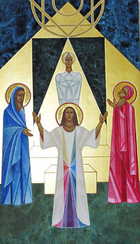
The Raising of Lazarus
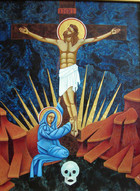
Crucifixion
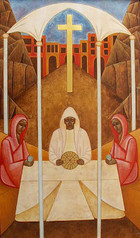
The Supper at Emmaus
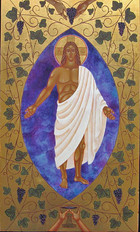
Christ the True Vine
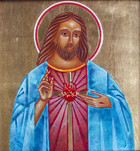
The Sacred Heart of Jesus
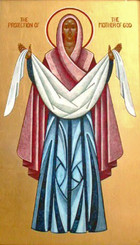
The Mother of God of Protection
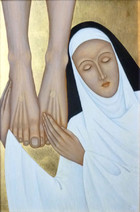
St. Catherine of Siena at the Feet of Christ
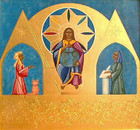
Julian of Norwich & Teresa of Avila in Holy Conversation
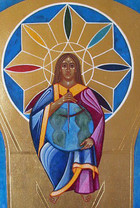
Julian of Norwich & Teresa of Avila in Holy Conversation (Detail)
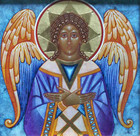
The Angel of Silence

